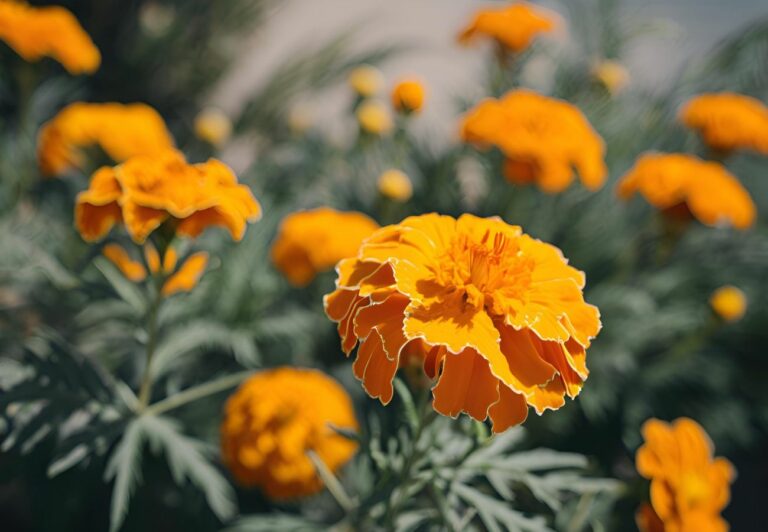Flowers are far more than just beautiful decor—they’re storytellers, peace-offerers, and joyful companions that accompany us through life’s most meaningful moments. From religious rituals to national holidays and everyday greetings, flowers hold powerful symbolism across cultures and continents.
At B&M Florist, we believe in the universal language of flowers. So today, let’s travel the world together through petals and perfume, exploring how different cultures celebrate with blooms.
India: Marigolds and Jasmine for Spiritual Blessings
In India, flowers are deeply woven into the cultural and spiritual fabric of everyday life. Marigolds—vibrant in orange and yellow hues—are a staple in Hindu worship and celebrations. They are believed to represent purity, prosperity and devotion, and are often used to create elaborate garlands that adorn homes, temples, and deities.
Jasmine, on the other hand, is considered sacred and calming. Its sweet scent fills the air during weddings and religious ceremonies. Brides might wear fresh jasmine in their hair as a symbol of grace, love, and good fortune.
Inspiration for the home: Add a string of marigolds or jasmine to your entryway or hang one above a mirror. It’s an easy way to bring a sense of calm and sacred beauty into your space.
Mexico: Marigolds and Meaning on Día de los Muertos
Día de los Muertos (Day of the Dead) is a rich and vibrant tradition in Mexico, where families honour and remember their ancestors. Flowers—especially the bright orange cempasúchil, or Mexican marigold—play a central role.
These flowers are believed to guide spirits back to the world of the living with their strong fragrance and brilliant colour. Families decorate altars (ofrendas) with marigolds, candles, photos, and food offerings to welcome their loved ones back for a joyful reunion.
Why it’s beautiful: It’s a powerful example of how flowers can be used not just for mourning, but as a symbol of love, remembrance, and the cycle of life.
Japan: The Reverence of Cherry Blossoms
Few floral events are as iconic as Japan’s hanami, or cherry blossom viewing. Every spring, families, friends and co-workers gather under blooming sakura trees to celebrate the fleeting beauty of life.
Cherry blossoms symbolise renewal, impermanence, and mindfulness—a reminder to savour the present moment. The blooming season is brief, often just a couple of weeks, making it all the more treasured.
Try it at home: Bring that sense of peace and reflection into your space with pale pink cherry blossom stems in a minimalist vase. Pair them with soft lighting for a gentle, meditative atmosphere.
Thailand and Southeast Asia: Offerings of Orchids and Lotus
In Thailand, flowers are an essential part of Buddhist rituals. The lotus flower holds special significance—it represents spiritual purity, enlightenment, and resilience. Often, worshippers bring lotus blossoms to temples as offerings to Buddha.
Orchids are another popular bloom in Southeast Asian culture. With their sculptural elegance and longevity, they’re seen as symbols of beauty, strength, and wealth. They’re frequently gifted during festive occasions and used in home altars.
Style tip: Add an orchid arrangement to your living room for an instant touch of sophistication and serenity. White or purple varieties can elevate a space with their quiet strength.
Italy: Romantic Gestures and the Language of Flowers
In Italy, flowers are a form of passionate expression. Whether gifted on name days, anniversaries, or Sunday lunches with Nonna, flowers carry layers of meaning.
Red roses, of course, signify love and romance, while sunflowers represent loyalty and adoration. Florists across the country are well-versed in floriography—the language of flowers—and use it to craft bouquets that say exactly what the sender feels.
Pro tip: Want to send a message through your flowers? A bouquet with red roses, white lilies, and pink carnations might say: “I love you deeply, admire your grace, and cherish our friendship.” (Now that’s amore.)
Australia: Native Blooms for Connection and Country
Here at home, Australia’s unique native flora plays an important role in cultural expression. Wattle, our national flower, symbolises resilience and unity. Its bright yellow blooms are celebrated every 1st of September for National Wattle Day.
Waratahs, banksias, and kangaroo paw are also celebrated in floral arrangements, both traditional and modern, for their bold shapes and rich colours. Indigenous communities have long used native plants not only for ceremony, but for storytelling and connection to Country.
Decorating with purpose: Choose native Australian blooms to honour this land’s natural beauty. They’re long-lasting, low-maintenance, and full of character.
Egypt: Lotus Flowers for Life Eternal
In ancient Egypt, the blue lotus (actually a water lily) was considered sacred. It was often depicted in hieroglyphics and artwork as a symbol of the sun, creation, and rebirth. The flower’s ability to open with the sun and close at night made it a powerful spiritual metaphor.
Lotuses were used in both life and death—woven into daily rituals and even placed in tombs to guide souls to the afterlife.
Why it matters today: It’s a timeless reminder of hope, transformation, and the mystery of life. Whether you’re gifting a floral arrangement or meditating on your own path, the lotus remains a meaningful muse.
Final Thoughts: Flowers as a Global Love Language
Across the globe, flowers help us express what words often can’t—love, gratitude, remembrance, hope. Each culture adds its own unique meaning and magic, reminding us that even though we may live oceans apart, our appreciation for nature’s beauty is something we all share.
Next time you send a bouquet or pick flowers for your home, consider their deeper significance. A small bloom can carry centuries of tradition, symbolism, and heart.
At B&M Florist, we’re proud to honour global floral traditions in every stem we select and every story we help tell. Whether you’re celebrating, remembering, or simply decorating with love—there’s a world of meaning in your flowers.




